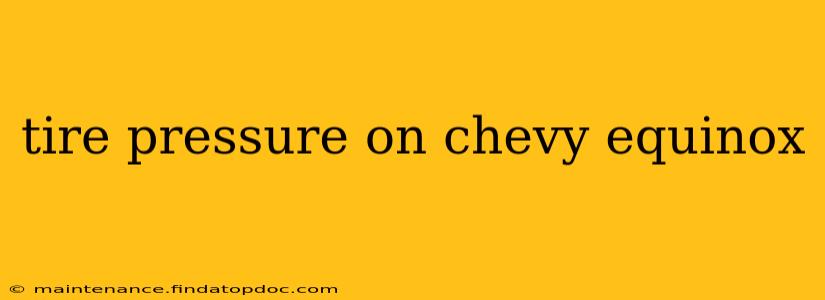Maintaining the correct tire pressure in your Chevy Equinox is crucial for safety, fuel efficiency, and tire longevity. Incorrect tire pressure can lead to uneven wear, reduced handling, and even tire blowouts. This guide will cover everything you need to know about finding and maintaining the optimal tire pressure for your Equinox.
Where Can I Find the Recommended Tire Pressure for My Chevy Equinox?
The recommended tire pressure for your Chevy Equinox isn't a one-size-fits-all answer. It varies depending on several factors, including your specific Equinox model year, trim level, and whether you're using the standard tires or have opted for an upgrade. The most reliable place to find this information is within your vehicle itself:
- Driver's Side Doorjamb: Look at the sticker on the driver's side doorjamb. This sticker provides crucial information, including the recommended tire pressure (both for normal driving and when the vehicle is fully loaded). This is your primary source of truth.
- Owner's Manual: Your owner's manual also contains detailed information on tire pressure, including specifics for different tire sizes and loading conditions.
Never rely on the tire pressure printed on the tire sidewall. This pressure is the maximum pressure the tire can handle, not necessarily the recommended pressure for optimal performance and safety in your Equinox.
What is the Correct Inflation Pressure for My Chevy Equinox Tires?
As mentioned, the correct inflation pressure is specific to your vehicle. However, you'll generally see recommendations in the range of 30-35 PSI (pounds per square inch) for most Chevy Equinox models. Always check the sticker on your driver's side doorjamb or your owner's manual for the precise recommended pressure for your specific vehicle. This pressure is usually given in two figures: one for normal driving and another for when the vehicle is heavily loaded.
How Often Should I Check My Chevy Equinox's Tire Pressure?
Checking your tire pressure regularly is vital for safety and optimal performance. Aim to check your tire pressure at least once a month, or more frequently if you regularly travel long distances or drive in extreme temperatures (very hot or very cold weather can significantly impact tire pressure).
What Happens if My Chevy Equinox Tire Pressure is Too Low or Too High?
Maintaining the correct tire pressure is essential for several reasons:
- Too Low: Under-inflated tires lead to increased fuel consumption, uneven tire wear (primarily on the outer edges), reduced handling and braking performance, and a higher risk of tire failure.
- Too High: Over-inflated tires can lead to a harsher ride, uneven wear (primarily in the center of the tire), and increased risk of tire failure due to excessive stress.
Always aim for the recommended tire pressure specified in your owner's manual or the sticker on your driver's side doorjamb.
How Do I Check My Chevy Equinox Tire Pressure?
You'll need a reliable tire pressure gauge to check your tires. Follow these steps:
- Cool Tires: Always check your tire pressure when the tires are cool (i.e., the vehicle hasn't been driven recently). Driving will heat the tires, raising the pressure.
- Unscrew the Valve Cap: Remove the valve cap from the tire valve stem.
- Attach the Gauge: Press the gauge firmly onto the valve stem.
- Read the Pressure: The gauge will display the tire pressure.
- Add or Remove Air: If the pressure is too low, add air using a portable air compressor or at a gas station. If the pressure is too high, carefully release air using the valve stem.
- Replace the Valve Cap: Once the pressure is correct, replace the valve cap.
What is the Spare Tire Pressure for My Chevy Equinox?
The spare tire pressure is often different from the regular tires. Check the information label on your spare tire, and if it doesn't provide a pressure, consult your owner's manual for this specification. Spare tires are usually temporary and not intended for prolonged use at high speeds.
By following these guidelines, you can ensure your Chevy Equinox's tires are properly inflated, contributing to a safer, more comfortable, and more fuel-efficient driving experience. Remember, regular checks are key to preventing potential problems.
